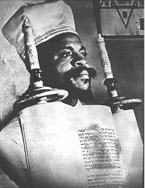Wentworth Arthur Matthew facts for kids
Wentworth Arthur Matthew (born June 23, 1892 – died December 1973) was a religious leader. He moved to New York City from the West Indies. In 1919, he started a group called the Commandment Keepers of the Living God. This group was for Black Hebrews.
Matthew was inspired by Marcus Garvey and his ideas about Black people. Matthew taught that his followers were returning to Judaism. He believed they were the true Hebrews. In 1930, he officially registered his group. He moved the congregation to Brooklyn. There, he created the Israelite Rabbinical Academy. This school taught and ordained African-American rabbis. However, traditional Jewish groups do not accept his theory of Black Hebrews.
Matthew often said he was born in Lagos, Nigeria. But other records, including his own, show he was born in St. Kitts, British West Indies. He and his family became United States citizens.
Early Life and Family
Wentworth Arthur Matthew was born in 1892 on Saint Kitts. This island was part of the British West Indies. He married Florence (born 1893, died 1980). She was also from the British West Indies. They had at least four children together. Their children were Arthur, Florence, Samuel E., and Joseph.
Later in his life, Matthew sometimes said he was from Lagos, Nigeria. But in his official papers, like his 1927 naturalization form, he listed his birthplace as Spooner's Village, British West Indies. When he registered for the US Selective Service in 1942, he again listed St. Christopher, British West Indies, as his birthplace.
Building a New Community
Matthew moved to New York City. His family joined him there. In 1919, he started the Commandment Keepers Congregation of the Living God. This was in Harlem. It was a Black Hebrew movement. He was influenced by the white Jewish people he met. He also learned about the Beta Israel people of Ethiopia. He began to feel a connection to them.
Matthew trained rabbis. These rabbis then started synagogues in many parts of the United States and the Caribbean. Many older members of this community remember their parents following Jewish dietary laws. For example, they would not eat pork. They also salted their meat.
Matthew and his group were also inspired by Marcus Garvey. Garvey was from Jamaica. He led a Black nationalist group called the Universal Negro Improvement Association. Rabbi Arnold Josiah Ford was part of this movement. He wrote the Universal Ethiopian Anthem. He also led the UNIA band and choir.
Matthew's teachings said that African-Americans were the original Jews. He believed they were descendants of the Lost Tribes. He thought that white or European Jews were from the Khazars. He believed they had kept Judaism alive. Black Hebrews spoke of "returning" to Judaism.
However, traditional Jewish groups did not agree with Matthew's ideas. They believed that people are Jewish if their mother is Jewish. Or, they must complete a recognized conversion. Matthew eventually realized that his Black Hebrew congregations would not be accepted by the wider Jewish community.
Matthew's congregation followed many traditional Jewish laws. But they also had some unique practices. Men and women sat separately during services. They used standard Orthodox Jewish prayer books. They also followed the laws of Shabbat (the Sabbath) and kashrut (dietary laws).
In 1930, Matthew officially registered his congregation. It later moved to Brooklyn. There, he founded the Israelite Rabbinical Academy. At this school, he taught and ordained rabbis for his movement.
Today, many Black Hebrews and Black Hebrew Israelites follow Wentworth Matthew's teachings. These groups have developed in different ways. Matthew believed that Black people who converted to Judaism were not converting. Instead, he felt they were "returning" to their original faith.
Matthew tried twice to join the New York Board of Rabbis. But he was not accepted. He did not meet their rules for Jewish descent or conversion. They also did not want African or Caribbean practices in Jewish worship. After Matthew died in 1973, there was less connection between Black Jewish groups and white congregations.
His Lasting Impact
Rabbis trained at the Israelite Rabbinical Academy have become leaders for Black Hebrews. They lead groups in many cities. For example, Capers Funnye, Jr. of Chicago studied with Levi Ben Levy. Levy was a leader in the Hebrew Israelite movement. He came from the Commandment Keepers tradition.
In 1985, Funnye became an assistant rabbi. He worked at the Beth Shalom B'nai Zaken Ethiopian Hebrew Congregation in Chicago. He now leads this congregation. It is the largest Black Jewish or Black Hebrew group in the US. Funnye also completed a conversion recognized by a traditional Jewish court. He earned a Bachelor of Arts degree in Jewish Studies. He also got a Master of Science degree from the Spertus Institute of Jewish Studies.
Capers Funnye has worked for many years to build connections with traditional Judaism. In 1995, he helped start the Alliance of Black Jews. This group aimed to connect all types of African-American Jews. It is no longer active.
Shais Rishon, a Black Orthodox Jewish writer, has said that Matthew was not Jewish. He believes Matthew never belonged to or converted to any part of Judaism.


